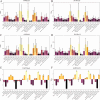Trends in deaths and disability-adjusted life-years of ischemic heart disease attributable to high body-mass index worldwide, 1990-2019
- PMID: 39261774
- PMCID: PMC11389382
- DOI: 10.1186/s12872-024-04136-y
Trends in deaths and disability-adjusted life-years of ischemic heart disease attributable to high body-mass index worldwide, 1990-2019
Abstract
Background: The objective of this study is to evaluate the global burden of ischemic heart disease (IHD) attributable to High body mass index (HBMI) by utilizing data from Global Burden of Disease (GBD) 2019.
Methods: This study utilized data from the GBD 2019 to examine the impact of HBMI on deaths and disability-adjusted life years (DALYs). The analysis focused on age-standardized rates and considered a 30-year time frame. Trends were assessed using estimated annual percentage changes (EAPCs).
Results: Since 1990, a significant global increase in IHD attributable to HBMI has been observed. This increase is particularly notable among elderly males and in regions with low-middle Socio-Demographic Index (SDI), such as Central Asia and Eastern Europe. In 2019, IHD globally resulted in 1,662,339 deaths and 41,369,773 DALYs. Despite the high age-standardized death rate (20.73 per 100,000) and DALY rate (499.41 per 100,000), a declining trend was noted. This trend is reflected by the EAPCs of -0.35 for DALYs and - 0.67 for deaths. Notably, males and middle SDI countries exhibited higher rates of IHD, whereas high SDI regions such as High-income Asia Pacific and Western Europe showed decreasing trends in IHD.
Conclusion: Over the past three decades, there has been a significant increase in IHD caused by HBMI, especially in low-middle and low SDI regions. This highlights the importance of targeted interventions in addressing this issue. Notably, regions including Central Asia, Eastern Europe, North Africa, and the Middle East have been heavily affected.
Keywords: EAPC; High body mass index; Ischemic heart disease; Socio-Demographic Index.
© 2024. The Author(s).
Conflict of interest statement
The authors declare no competing interests.
Figures

Similar articles
-
Global burden trends and future predictions of ischemic heart disease attributable to air pollution in people aged 60 years and older, 1990-2021.Front Public Health. 2025 Jul 4;13:1598092. doi: 10.3389/fpubh.2025.1598092. eCollection 2025. Front Public Health. 2025. PMID: 40687134 Free PMC article.
-
Global, regional, and national burden of IHD attributable to PM pollution aged 70 and above: an age-period-cohort modeling and frontiers analysis study.Front Public Health. 2025 Jun 4;13:1573599. doi: 10.3389/fpubh.2025.1573599. eCollection 2025. Front Public Health. 2025. PMID: 40535449 Free PMC article.
-
Global, regional, and national burden of maternal disorders, 1990-2021: a systematic analysis from the global burden of disease study 2021.BMC Public Health. 2025 Jul 29;25(1):2576. doi: 10.1186/s12889-025-23814-w. BMC Public Health. 2025. PMID: 40730990 Free PMC article.
-
Global burden and risk factors of musculoskeletal disorders among adolescents and young adults in 204 countries and territories, 1990-2019.Autoimmun Rev. 2023 Aug;22(8):103361. doi: 10.1016/j.autrev.2023.103361. Epub 2023 May 23. Autoimmun Rev. 2023. PMID: 37230312 Review.
-
The contribution of major depression to the global burden of ischemic heart disease: a comparative risk assessment.BMC Med. 2013 Nov 26;11:250. doi: 10.1186/1741-7015-11-250. BMC Med. 2013. PMID: 24274053 Free PMC article.
Cited by
-
Global, regional, and national burden of cardiovascular disease attributable to high body mass index from 1990 to 2021 and projection to 2045.Front Endocrinol (Lausanne). 2025 Apr 28;16:1546176. doi: 10.3389/fendo.2025.1546176. eCollection 2025. Front Endocrinol (Lausanne). 2025. PMID: 40357206 Free PMC article.
References
-
- Busetto L, Dicker D, Frühbeck G, Halford JCG, Sbraccia P, Yumuk V et al. A new framework for the diagnosis, staging and management of obesity in adults. Nat Med. 2024. - PubMed
-
- Ryan DH, Barquera S, Cavalcanti OB, Ralston J. The Global Pandemic of Overweight and Obesity. Handbook of Global Health. 2020.
-
- Wagner KH, Brath H. A global view on the development of non communicable diseases. Prevent Med. 2012;54 Suppl:S38–41. - PubMed
Publication types
MeSH terms
Grants and funding
LinkOut - more resources
Full Text Sources
Medical
Miscellaneous

